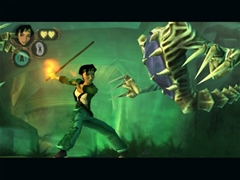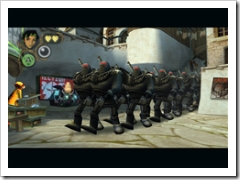In the Beginning
This is the second of my “Player P.O.V” series of articles, that examines the way the best games involve and entertain the player. The previous article, Shining Force III, is here.
It’s a joint project between myself and my brother, Phil over at Sodaware. My articles will focus on player experience, and his deal with lessons game developers can learn from these great games.
You can read his article here.
Both our articles are featured in October’s Carnival of Gamers, which you can find at Man Bytes Blog. If you’re here from Man Bytes Blog, welcome! Bookmark us with Ctrl + D, subscribe to the RSS feed and enjoy your stay!
This time I’m looking at the Ubisoft classic Beyond Good and Evil.
Beyond Good and Evil
Developer: Ubisoft
European release: November 2003
Platform: PC, PS2, Xbox, Gamecube
Ancient Chinese Secrets

The deepest way BG&E creates its connection with the player is by locking the story onto the main character, the journalist Jade. Although it’s a third-person adventure, we see through Jade’s eyes when using her camera to photograph animals, or during her IRIS reports. This creates a true sense of discovery, as neither player nor character is ahead of the other; you find out the truth at the same instant by sharing the same view.
Home Sweet Home
You never lose your connection with Jade. As far as I recall, she is present in every scene in the game. Aspects of the story come from other characters, of course, but they’re all delivered to Jade, not without her:
- News bulletins are used by the Alpha Sections;
- M-disks – essentially DVDs – reveal security footage and personal messages from absent friends;
- Emails – newsletters, notes from friends and those assisting your quest.
 All this helps Beyond Good and Evil to achieve the focus it needs. Although its story deals with an entire planet under threat, it has the emotional clarity due to its total devotion to this one character. It reminds me of what was wrong with The Day After Tomorrow, where the viewer was so often separated from its main character that the film’s core was misplaced. Here, Ubisoft maintain this tight grip on Jade, making her the game’s driving force.
All this helps Beyond Good and Evil to achieve the focus it needs. Although its story deals with an entire planet under threat, it has the emotional clarity due to its total devotion to this one character. It reminds me of what was wrong with The Day After Tomorrow, where the viewer was so often separated from its main character that the film’s core was misplaced. Here, Ubisoft maintain this tight grip on Jade, making her the game’s driving force.
Dancing with Domz
The game starts almost instantly, with the player taking control of Jade at the first opportunity. The short intro works brilliantly well, not just because it means you get to play more quickly – which is absolutely crucial – but by playing on certain conventions and player awarenesses.
As soon as the pompous horns blurt out their tune and the overbearing Alpha Sections begin their speech, the game has made you aware you’re watching a news bulletin, something we’re all familiar with, regardless of whether the subjects are Domz and Hyllis or something slightly more Earthly.
 The media I listed earlier are used to present this strange world to the player in much the same way as our own. We watch news bulletins, films, read emails and so on about our own world, so why not Hyllis? Rather than create a bizarre and arbitrary way of communication, Ubisoft use the best mankind has collectively designed in its history. Pretty smart, and much cheaper too, I’m sure.
The media I listed earlier are used to present this strange world to the player in much the same way as our own. We watch news bulletins, films, read emails and so on about our own world, so why not Hyllis? Rather than create a bizarre and arbitrary way of communication, Ubisoft use the best mankind has collectively designed in its history. Pretty smart, and much cheaper too, I’m sure.
Thoughtful Reflections
The deeper point to presenting Hyllis like Earth is to emphasise the game’s major issue, that of received information. Through its journalist elements BG&E promotes independent thinking, and the importance of being active in meaning and knowledge. It might not be tackling global warming or trying to unearth a huge Government conspiracy, but any game with an actual, proper moral other than kill/steal/pimp has to be worth celebrating.
Organic Beauty
This is all well and good, but what makes Beyond Good and Evil fun to play? In amidst all the multimedia intertextuality and the talking rhinos, did Ubisoft put any good gameplay in there?
Yes, they did. And you get to it almost straight away. The first time the game hands control over to you is in a multi-enemy battle, with nothing more than a useful icon in the corner indicating which button is “fight”. Jade’s already an Aikido master who carries her staff with her all the time, which Ubisoft thankfully realised would make a training section pretty redundant. Far be it from me to come over all “Game Design Lessons”, but certain game developers could learn a lesson from this.
The battling is fun, and plays out like Darth Maul in a Zelda game. Spins, smashes and flips are all carried off with the analogue stick and that useful “fight” button. There’s one special move which you carry off by holding down attack, and that’s pretty much it; no need for finger-knotting attacks, just simple, intuitive controls.
Travelling around Hyllis in your hovercraft is also pretty awesome, as you’d expect from a sea-and-land vehicle with lock-on lasers, guns, boosts and jump jets. Most of these you buy with your precious pearls, which lets you get to new areas and animals.
Say Cheese, Fellas
 Taking photos of the many animals on Hyllis provides you with both forms of the game’s currency, namely credits and pearls. Credits buy you little things (and sometimes pearls), and the pearls buy you upgrades at Mammago garage, they of the talking Jamaican rhinos.
Taking photos of the many animals on Hyllis provides you with both forms of the game’s currency, namely credits and pearls. Credits buy you little things (and sometimes pearls), and the pearls buy you upgrades at Mammago garage, they of the talking Jamaican rhinos.
The camera’s interface is again very simple, with just point, zoom and click. A certain icon appears on screen when you point it at specific things – a paw for an animal, for example – and a bar fills until it’s in focus. Unfortunately you can’t look back over your entire album unless you photograph every single animal on the planet, but you can look over shots on your current roll, and previous assignments. A more extensive gallery would have been nice, or some form of scoring system, but you can’t argue with a game where you uncover secret identities not with a gun but a very long zoom lens.
Redemption
Beyond Good and Evil is a tremendous game, which is perhaps wider than it is deep. The mixture of different gameplay styles naturally means some excel – combat is often a highlight – and others do less well – stealth mode’s Flying Death Lasers.
On the whole, its pin-sharp focus on the main character and the player’s relationship with her creates a bond that is strong enough to paper over some of the game’s flaws.
If you’d like to read more about Beyond Good and Evil, check out Phil’s fantastic Game Design Lessons article over at Sodaware, or my previous article on the game, “The best game of this generation“.
 My name is James Newton, and this is my website - a collection of my writings about
videogames, music and all my other thoughts.
My name is James Newton, and this is my website - a collection of my writings about
videogames, music and all my other thoughts.